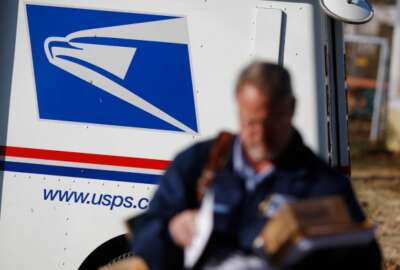
OPM outlines plan to migrate 1.7M FEHB enrollees into postal-only insurance marketplace
The Office of Personnel Management is outlining its plan to migrate nearly 2 million individuals covered under the Federal Employees Health Benefits (FEHB) Program...
The Office of Personnel Management is outlining its plan to migrate nearly 2 million individuals covered under the Federal Employee Health Benefits (FEHB) Program to a new postal-only health insurance marketplace.
OPM is creating the Postal Service Health Benefits Program as required under the Postal Service Reform Act signed into law a year ago.
The agency anticipates a much busier Open Season next year in 2024 than in prior years, because 1.7 million postal employees, annuitants and eligible family members will have to switch to the new postal-only insurance marketplace.
OPM Associate Director for Health Care and Insurance Laurie Bodenheimer said the agency is looking to give individuals and providers clarity on the upcoming change through an interim final rule published last Thursday.
“[There’s] lots of work ahead of us, and it’s really picked up quite a bit of speed. This [interim final rule] was crucial to sort of laying the foundation for how we see the program operating,” Bodenheimer said in an interview.
The project is a cross-agency effort between OPM’s health care and insurance, retirement services and the chief information officer. OPM, in its fiscal 2024 budget request to Congress, said 2024 will be a “pivotal year,” to get the PSHB up and running.
“One of the things that made us a combination of excited and terrified at the same time, is that we were given this opportunity to create a new health benefits program for a large population, and so we absolutely want to do this right, with the best interests of the enrollees always in mind,” Bodenheimer said.
OPM anticipates the non-postal federal workforce could see a slight decrease in their FEHB premiums once the PSHB launches.
The Congressional Budget Office estimates postal enrollees in PSHB could also see slightly lower premiums, since postal retirees will primarily be covered under Medicare Parts A and B.
OPM, however, concedes in its interim final rule that the actual total costs and benefits associated with the Postal Service Reform Act — as well as the creation of the PSHB — are “highly uncertain.”
“The segmentation of the current FEHB risk pool will result in premiums reflective of each separate risk pool’s health care utilization and costs, which are estimated to be higher for Postal Service enrollees compared with non-postal,” OPM’s interim final rule states.
The Postal Service Reform Act eliminated a USPS requirement to prefund retiree health benefits well into the future, and forgave $57 billion in scheduled payments and didn’t contribute to the fund.
“Obviously, the creation of the Postal Service Health Benefits program was a significant part of the potential cost savings for the Postal Service, but it wasn’t the only thing in the act that was designed to help them save money,” Bodenheimer said.
USPS will return to a pay-as-you-go system for funding retiree health benefits starting in June 2026, based on OPM calculations as outlined in the legislation. OPM will recalculate USPS’s obligation to pay those retiree health benefits each June.
OPM in its interim final rule said the elimination of the prefunding mandate will improve the long-term financial stability of USPS.
“With greater financial stability for the Postal Service, current Postal Service employees, Postal Service annuitants, and their family members will also see greater stability in their future health insurance coverage and other benefits,” the agency wrote.
Bodenheimer said OPM will begin to accept applications from providers looking to offer plans in June, and will accept applications through the end of August.
“We need to both assess and decide which carriers should be approved to be a postal health benefits plan,” she said.
Next year, OPM will review plan proposals and negotiate those rates and benefits.
Bodenheimer said most FEHB providers, in an informal survey, expressed an interest in providing plans for the PSHB. Other providers, she added, said they were “tentative” about their plans until they saw the interim final rule from OPM.
“We are engaged in conversations [and] dialogue, and want to make sure that there is sufficient choice for every postal-eligible person to have a good amount of plans to choose from — even some of the smaller plans that they may currently be enrolled in,” Bodenheimer said.
OPM and USPS, as well as several supporting agencies, expect to spend more than $100 million to launch the PSHB, and an additional $75 million in fiscal 2024. Agencies expect to spend about $51 million each following year to administer the program.
OPM expects it will need 153 full-time employees to manage contract oversight, program operations, systems maintenance, customer service, policy support and general support.
The Postal Service Reform Act requires all future USPS annuitants and their eligible family members who are entitled to Medicare Part A must also enroll in Part B, unless an exception applies.
USPS annuitants enrolled in Medicare and enrolled in a PSHB plan that would have Medicare serve as their primary coverage and their PSHB plan as secondary coverage.
OPM estimates that in 2021, 75% of Postal Service annuitants aged 65 and over had enrolled in Medicare Part B.
While current USPS retirees aren’t required to enroll in Medicare Part B, OPM estimates approximately 100,000 USPS annuitants and their eligible family members will be eligible to enroll in Part B during the six-month Special Enrollment Period that will begin on April 1, 2024.
The Centers for Medicare and Medicaid Services will launch the six-month special enrollment period, which will allow USPS annuitants and their family members to enroll in Medicare Part B without a late enrollment penalty.
PSHB plans will offer the same enrollment types as FEHB plans, including self-only, self-plus one, and self and family coverage.
USPS is tasked with educating employees and retirees about the health care changes, but Bodenheimer said the agency is working with OPM to make sure messaging to enrollees is accurate and understandable.
If postal enrollees don’t make a change by the end of the 2024 Open Season, Bodenheimer said OPM will move them to the lowest-cost nationwide postal plan that doesn’t have a membership fee.
“We wanted people to have a choice as they make this transition, which quite frankly, will be difficult for many folks. Even during normal FEHB Open Season, people are often overwhelmed by the choices that they have, and maybe sometimes don’t make a change.”
Bodenheimer said this is consistent with what OPM does for FEHB enrollees in a plan that no longer participates in the program.
“Every year there may be an FEHB plan that decides not to participate anymore, and if an annuitant loses coverage, they can’t get it back,” she said. “So there has always been a process to make sure that they maintain an enrollment, even if they come in later or [at] the next Open Season and say ‘I want out of this plan.'”
Copyright © 2024 Federal News Network. All rights reserved. This website is not intended for users located within the European Economic Area.
Jory Heckman is a reporter at Federal News Network covering U.S. Postal Service, IRS, big data and technology issues.
Follow @jheckmanWFED





